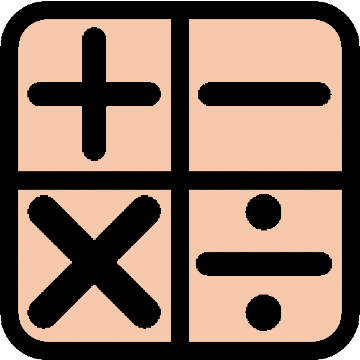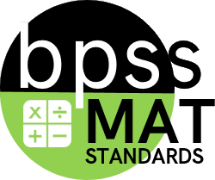MAT-00.NO  MAT-00.NO MAT-00.NO Domain  | (NO) Number and Operations Learners will develop a foundational understanding of the number system, operations, and computational fluency to create connections and solve problems within and across concepts.
|
Sub-Categories- (CC) Counting and Cardinality
Learners will understand the relationship between numerical symbols, names, quantities, and counting sequences. - (NBT) Number Base Ten
Learners will understand the place value structure of the base-ten number system and represent, compare, and perform operations with multi-digit whole numbers and decimals. - (NF) Number Fractions
Learners will understand fractions and equivalency to represent, compare, and perform operations of fractions and decimals. - (NS) Number System
Learners will expand their knowledge of the number system to create connections and solve problems within and across concepts. - (O) Operations
Learners will expand their computational fluency to create connections and solve problems within and across concepts.
Calculation Method for DomainsDomains are larger groups of related standards. The Domain Grade is a calculation of all the related standards. Click on the standard name below each Domain to access the learning targets and rubrics/ proficiency scales
for individual standards within the domain. |
|
MAT-00.NO.CC.01

|
Kindergarten (MAT) Targeted Standard
(NO) Number and Operations
(CC) Counting and Cardinality
Learners will understand the relationship between numerical symbols, names, quantities, and counting sequences.
|
MAT-00.NO.CC.01 Count verbally in sequential order by ones and tens to 100, making accurate decuple transitions (ex.89 to 90).
Count verbally forward from any given number within 100.*
 Proficiency Scale Proficiency Scale
Progressions
Counting Forward
-
MAT-00.NO.CC.01 Count verbally in sequential order by ones and tens to 100, making accurate decuple transitions (ex.89 to 90).
Count verbally forward from any given number within 100.
- MAT-01.NO.CC.01 Count forward by ones and tens from any given point
within 120.
- MAT-02.NO.CC.01 Count forward from any given number within 1000.
|
|
MAT-00.NO.CC.02

|
Kindergarten (MAT) Targeted Standard
(NO) Number and Operations
(CC) Counting and Cardinality
Learners will understand the relationship between numerical symbols, names, quantities, and counting sequences.
|
MAT-00.NO.CC.02 Count backward from 20 by ones and from a given number within 10.*
 Proficiency Scale Proficiency Scale
Progressions
Counting Backward
-
MAT-00.NO.CC.02 Count backward from 20 by ones and from a given number within 10.
- MAT-01.NO.CC.02 Count backward by ones and tens from any given number within 120.
- MAT-02.NO.CC.02 Count backward from any given number within 1000.
|
|
MAT-00.NO.CC.03

|
Kindergarten (MAT) Targeted Standard
(NO) Number and Operations
(CC) Counting and Cardinality
Learners will understand the relationship between numerical symbols, names, quantities, and counting sequences.
|
MAT-00.NO.CC.03 Identify and write any given numeral within 20.*
 Proficiency Scale Proficiency Scale
Progressions
Number Identification and Writing
-
MAT-00.NO.CC.03 Identify and write any given numeral within 20.
- MAT-01.NO.CC.03 Represent several objects with a written numeral up to 120.
- MAT-02.NO.CC.03 Read and write numbers up to 1,000 using standard, word, and expanded forms.
- MAT-03.NO.CC.01 Read and write numbers up to 10,000 using objects or visual representations including standard and expanded forms.
- MAT-04.NO.CC.01 Read numbers to the millions place including word, standard and expanded form. Write numbers to the millions place including standard and expanded form.
- MAT-05.NO.CC.01 Read, write, and compare decimals to the thousandths including standard and expanded forms.
|
|
MAT-00.NO.CC.04

|
Kindergarten (MAT) Targeted Standard
(NO) Number and Operations
(CC) Counting and Cardinality
Learners will understand the relationship between numerical symbols, names, quantities, and counting sequences.
|
MAT-00.NO.CC.04 Recognize and verbally label arrangements, without counting, for briefly shown collections up to 10 (e.g., "I saw 5." How do you know?" "I saw 3 and 2, that is 5.").*
 Proficiency Scale Proficiency Scale
Progressions
Subitizing
-
MAT-00.NO.CC.04 Recognize and verbally label arrangements, without counting, for briefly shown collections up to 10 (e.g., "I saw 5." How do you know?" "I saw 3 and 2, that is 5.").
- MAT-01.NO.CC.04 Recognize and verbally label arrangements, without counting, for briefly shown collections up to 20 (e.g., "I saw 16." "How did you know?" "I saw 10 and 6, that is 16.").
|
|
MAT-00.NO.CC.05

|
Kindergarten (MAT) Targeted Standard
(NO) Number and Operations
(CC) Counting and Cardinality
Learners will understand the relationship between numerical symbols, names, quantities, and counting sequences.
|
MAT-00.NO.CC.05 Count and tell how many objects up to 20 are in an arranged pattern or up to 10 objects in a
scattered configuration. Represent a quantity of up to 20 with a numeral.*
 Proficiency Scale Proficiency Scale
Progressions
Counting Patterns
-
MAT-00.NO.CC.05 Count and tell how many objects up to 20 are in an arranged pattern or up to 10 objects in a scattered configuration. Represent a quantity of up to 20 with a numeral.
- MAT-01.NO.CC.05 Skip count forward and backward by 5s and 10s from multiples and recognize the patterns of up to 10 skip counts.
- MAT-02.NO.CC.04 Skip count forward and backward by 2s and 100s and recognize the patterns of skip counts.
- MAT-10.DPS.09 Determine the number of outcomes using permutations and combinations in context.
- MAT-12.DPS.11 Use permutations and combinations to compute probabilities of compound events and solve problems.
|
|
MAT-00.NO.NBT.01

|
Kindergarten (MAT) Targeted Standard
(NO) Number and Operations
(NBT) Number Based Ten
Learners will understand the place value structure of the base-ten number system and represent, compare, and perform operations with multi-digit whole numbers and decimals.
|
MAT-00.NO.NBT.01 Compare two numbers between 1 and 20 using words greater than, less than, or equal to.*
 Proficiency Scale Proficiency Scale
Progressions
Place Value
-
MAT-00.NO.NBT.01 Compose and decompose numbers from 11 to 19 using a group of ten ones and some more ones using a model, drawing, or equation.
- MAT-01.NO.NBT.01 Demonstrate that the two digits of a two-digit number represent a composition of some tens
and some ones.
- MAT-02.NO.NBT.01 Understand that the three digits of a three-digit number represent a composition of some hundreds, some tens, and some ones.
- MAT-04.NO.NBT.01 Understand that in a multi-digit whole number, a digit in one place represents
ten times what it represents in the place to its right.
- MAT-05.NO.NBT.01 Understand that in a multi-digit number, a digit in one place represents 10 times as much as it represents in the place to its right and 1/10 of what it represents in the place
to its left.
- MAT-08.NO.NS.03 Use scientific notation to represent very large or very small quantities. Interpret scientific notation generated by technology. Compare and order numbers in scientific and standard notation.
|
|
MAT-00.NO.NBT.02

|
Kindergarten (MAT) Targeted Standard
(NO) Number and Operations
(NBT) Number Based Ten
Learners will understand the place value structure of the base-ten number system and represent, compare, and perform operations with multi-digit whole numbers and decimals.
|
MAT-00.NO.NBT.02 Compare two numbers between 1 and 20 using words greater than, less than, or equal to.*
 Proficiency Scale Proficiency Scale
Progressions
Compare Numbers and/or Expressions
-
MAT-00.NO.NBT.02 Compare two numbers between 1 and 20 using words greater than, less than, or equal to.
- MAT-01.NO.NBT.02 Compare two two-digit numbers using symbols >, <, and =. Justify comparisons based on the number of tens and ones.
- MAT-02.NO.NBT.02 Compare two three-digit numbers using symbols >, <, and =. Justify comparisons based on the value of thousands, hundreds, tens, and ones.
- MAT-03.NO.NBT.01 Compare two four-digit numbers using symbols, >, <, and =. Justify comparisons based on the value of thousands, hundreds, tens, and ones.
- MAT-04.NO.NBT.02 Compare two numbers to the millions place and decimals to the hundredths place, using symbols >, <, and =. Justify comparisons based on the value of the digits.
- MAT-05.NO.NBT.02 Compare two decimals to thousandths using symbols >, <, and =. Justify comparisons based on the value of the digits.
- MAT-06.NO.NS.01 Explain and show the relationship between non-zero rational numbers and their opposites using horizontal and vertical number lines in authentic problems. Use rational numbers to represent quantities in authentic contexts and explain
the meaning of 0 in certain situations.
- MAT-06.NO.NS.02 Write, interpret, and explain statements of order for rational numbers on a number line and in authentic contexts.
- MAT-07.NO.NS.01 Describe the absolute value of a number as its distance from zero on a number line.
- MAT-08.NO.NS.01 Compare and classify real numbers within the real number system.
- MAT-08.NO.NS.02 Use rational approximations of irrational numbers to compare the size of irrational numbers, locate them on a number line diagram, and estimate the value of irrational expressions involving one operation.
- MAT-08.NO.NS.03 Use scientific notation to represent very large or very small quantities. Interpret scientific notation generated by technology. Compare and order numbers in scientific and standard notation.
- MAT-09.AR.06 Solve linear equations and inequalities (to include compound inequalities) in one variable.
- MAT-09.AR.08 Graph the solution set to a two-variable system of linear equations. Create and graph the solution set to a two-variable system of linear inequalities in context.
- MAT-09.AR.09 Solve absolute value equations and inequalities in one or two variables.
- MAT-12.AR.09 Represent constraints by equations or inequalities and by systems of equations and/or inequalities and interpret solutions as viable or non-viable options in a modeling context.
|
|


